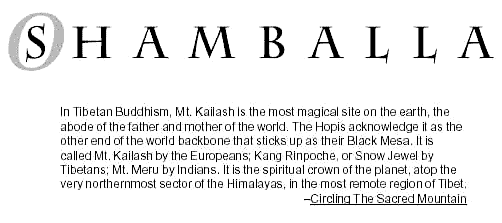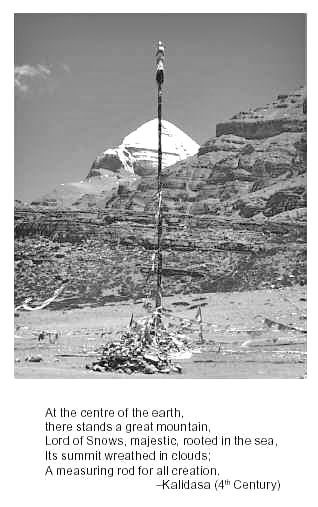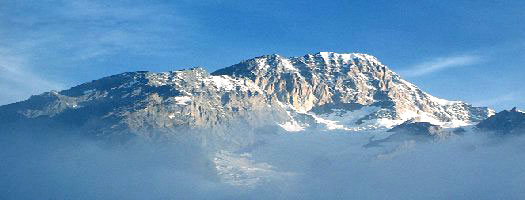|
by Linda
Casselman from LivingTheLight Website
People of all times from around the world have stood in awe when faced with majestic mountains.
From these sublime experiences have come myths about great mountains as homes of the gods, as stairways to the heavens, as pillars of the earth. One mountain range in particular inspired this kind of awe, wonder and devotion - the vast Himalayas.
Its grand peaks seemed to reach beyond the profane human realm and stretch up, touching the divine realm of the gods, so the Tibetans and Hindus saw the mountains as a means of transition between both the human and heavenly worlds.
The mountains were created, myth tells us, by the god Indra.
A huge herd of flying elephants had
displeased him, so he punished them by cutting off their wings and they
turned into the Himalayas. The mountains were important to all of the
gods for they all made sacrifices there. They were especially
significant to the god Shiva, however, whose paradise was on Mount
Kailas and whose deep meditation upon the mountain ensured the continued
existence of all things. The most sacred mountain of the whole Himalayan
range though was most definitely Mount Meru.
Well, Mount Kailas is an actual Himalayan mountain in the Ngari region
of Tibet. It rises 22,000 feet high from the edge of the Tibetan Plateau
and is highly inaccessible. It is Mount Kailas then that is the physical
embodiment of Mount Meru for the Buddhist and Hindu peoples.
Myths say that Meru rested on
the hood of the coiled primeval cobra Vasuki, who, it was said, caused
earthquakes when he yawned. It was also believed that the whole world
would be devoured by this ancient snake at the end of the present age,
world cycle.
They said that Mount Meru's slopes were studded with glittering gemstones and were thick with trees heavy with delicious fruit. Its peaks were rimmed with gold and a huge lake encircled it.
The divinity of this mountain is reflected in the religious objects of worship, yantras, of these peoples for the mountain is symbolized in their conical shape. Indeed, this majestic mountain inspired much awe in those who beheld it.
How could they not think it supported the cosmos and was home to a great god?
It commanded respect in its sublime beauty and the peoples of the region responded by holding it most sacred.
|



